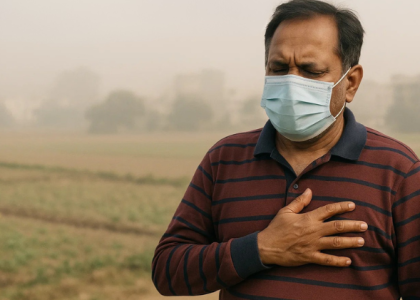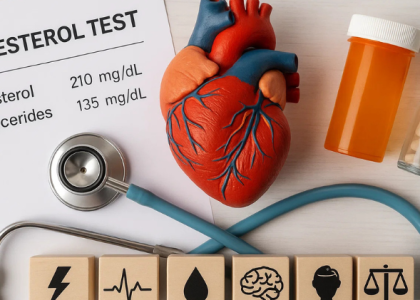Have you ever thought about what happens each time you take a breath in Delhi, Lahore, or Mumbai? The air filling your lungs might be doing more harm than you realize—especially to your heart.
The Invisible Enemy: PM2.5
That morning haze isn’t just blocking your view—it contains microscopic particles called PM2.5 that are silently damaging your cardiovascular system.
These particles are tiny—about 30 times smaller than a human hair—allowing them to bypass your body’s natural defenses. Once inside, they trigger inflammation that can eventually lead to heart attacks and strokes.
According to the World Health Organization, PM2.5 levels should not exceed 10-25 µg/m³ for safety. Above this threshold, these particles can cause a range of health problems including heart disease, heart failure, and heart attacks. Bangkokhearthospital
The Crisis in Our Region
If you live in South Asia, you’re breathing some of the world’s most dangerous air:
Recent reports show Pakistan has the third highest PM2.5 levels globally at 73.7 µg/m³, while India ranks fifth with 50.6 µg/m³—both far exceeding WHO safety guidelines. EcoWatch
New Delhi remains the world’s most polluted capital city for the sixth consecutive year, with PM2.5 concentrations of 91.8 µg/m³. CNN
This isn’t just an inconvenience—it’s a serious health emergency affecting millions.
Like Smoking Without a Cigarette
You wouldn’t voluntarily smoke cigarettes knowing the health risks, yet many of us have no choice but to breathe polluted air daily.
The comparison to smoking isn’t an exaggeration. Studies show that PM2.5 can alter biological changes in your cells, causing inflammatory responses throughout your body, thickening blood vessel walls, and inducing oxidative stress in your lungs—effects equivalent to those found in tobacco smoke. Bangkokhearthospital
Even if you’ve never smoked, living in a heavily polluted city means your heart faces similar dangers.
The Science: How Pollution Attacks Your Heart
When you breathe polluted air, here’s what happens inside your body:
Research shows that PM2.5 affects your cardiovascular system through three main mechanisms: increased oxidative stress, activation of inflammatory pathways in the immune system, and stimulation of the autonomic nervous system. These lead to blood vessel damage, hardening of arteries, and systemic inflammation that can trigger cardiovascular events. ScienceDirect
The tiny PM2.5 particles reach the smallest airways in your lungs. Some ultrafine particles may even enter your bloodstream and reach other organs. NCBI
Think of each breath in polluted air as adding a small amount of damage to your heart and blood vessels. Over time, this damage adds up.
The Numbers Don’t Lie
If you think the risk is small, consider this:
A major study following over 565,000 adults found that each increase of just 10 μg/m³ in PM2.5 exposure was associated with a 16% increase in deaths from ischemic heart disease and a 14% increase in deaths from stroke. PubMed
Even short-term exposure over a few hours to weeks can trigger cardiovascular disease-related events, while longer-term exposure over years increases the risk for cardiovascular mortality even more significantly. Circulation
These aren’t just statistics—they represent real people in our communities whose lives were cut short by air pollution.
You May Feel Fine Today, But…
Many people think, “I feel healthy, so air pollution isn’t affecting me.” This dangerous misconception ignores how cardiovascular damage builds silently over time.
The combined effect of high death rates and large populations means that China and India together account for 58% of the global mortality burden from PM2.5. In 2019 alone, approximately 980,000 deaths in India were attributed to PM2.5 exposure. Stateofglobalair
Just as high blood pressure often has no symptoms until it causes a crisis, air pollution damages your cardiovascular system without obvious warning signs.
Protecting Your Heart: Practical Steps
While we need systemic change for cleaner air, here are practical steps to protect yourself and your loved ones:
- Track Air Quality Daily: Use apps like AirVisual or check government websites for real-time PM2.5 levels in your area.
- Time Your Outdoor Activities: Exercise early morning when pollution levels are typically lower.
- Create a Clean Air Zone at Home: If possible, use HEPA air purifiers, especially in bedrooms where you spend 6-8 hours daily.
- Use Appropriate Masks: On high pollution days, N95 masks can filter most PM2.5 particles.
- Stay Well-Hydrated: Proper hydration helps your body clear toxins.
- Eat Anti-Inflammatory Foods: Include turmeric, ginger, fruits, vegetables, and omega-3 rich foods in your diet to help combat inflammation.
- Know the Warning Signs: Chest pain, unusual fatigue, shortness of breath—seek immediate medical help if you experience these symptoms.
Moving Forward Together
Air pollution isn’t just an individual problem—it requires community action and policy changes. However, understanding the connection between air quality and heart health empowers us to make better personal choices while advocating for cleaner air.
Remember: breathing toxic air is like smoking without the cigarette. The good news? Unlike age or genetics, air pollution is a modifiable risk factor for heart disease. By taking protective measures today, you can reduce your risk despite living in a polluted environment.
Dr. Priya Sharma is a cardiologist specializing in environmental cardiology at South Asian Heart Institute.
References:
- World Health Organization. PM2.5 Guidelines. 2024.
- IQAir. World Air Quality Report. 2025.
- Journal of the American Heart Association. 2024.
- Science Direct. PM2.5 and Cardiovascular Diseases Review. 2023.
- State of Global Air. Report. 2023.




